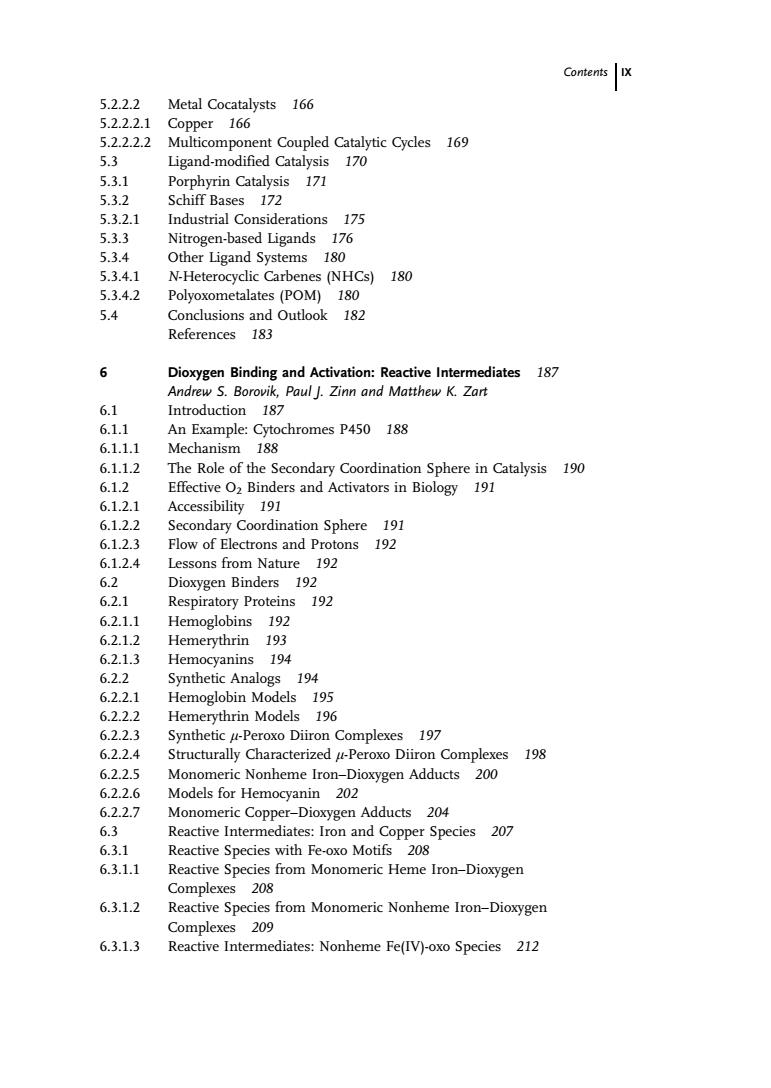正在加载图片...

Contents IX 5.22.2 Metal Cocatalysts 166 5.2.2.2.1 Copper 166 5.2.2.2.2 Multicomponent Coupled Catalytic Cycles 169 5.3 Ligand-modified Catalvsis 170 5.3.1 Porphyrin Catalysis 171 5.3.2 Schiff Bases 172 5321 Industrial Considerations 175 533 Nitrogen-based Ligands 176 5.3.4 Other Ligand Systems 180 5.3.41 N-Hete yclic Carbenes (NHCs)180 5.3.4.2 5.4 ions and Outlook References 6 Dioxygen Binding and Activation:Reactive Inte ediates 187 Andrew S.Borovi Paul Zinn and Matthew K.Zart 6.1 ntroduction 18. 6.1.1 An Example:Cytochromes P450 188 6.1.1.1 Mechanism 188 6.1.1.2 The Role of the Secondary Coordination Sphere in Catalysis 190 6.12 Effective O2 Binders and Activators in Biology 191 6121 Accessibility 191 6122 Secondary Coordination Sphere 191 61)2 Flow of Electrons and Protons 192 6.12.4 Lessons from Nature 192 6.2 Dioxygen Binders 192 6.21 192 e moglobins 102 6.22 Synthet nalogs 9 6.22.1 Hemoglobin Models 195 6.2.2.2 Hemerythrin Models 196 6.2.2.3 Synthetic #-Peroxo Diiron Complexes 197 6.2.2. Structurally Characterized u-Peroxo Diiron Complexes 198 6.2.2.5 Monomeric Nonheme Iron-Dioxygen Adducts 200 6.2.2.6 Models for Hemocyanin 202 6227 Monomeric Coppe er-Dioxygen Adducts 204 63 6.3.1 Reactive Species with Fe-oxo Motifs 208 6.3.11 Reactive Species from Monomeric Heme Iron-Dioxyger Compl 208 6.3.12 e Species from Monomeric Nonheme Iron-Dioxyger omple 6.3.13 Reactive Intermediates:Nonheme Fe(IV)-oxo Species 2125.2.2.2 Metal Cocatalysts 166 5.2.2.2.1 Copper 166 5.2.2.2.2 Multicomponent Coupled Catalytic Cycles 169 5.3 Ligand-modified Catalysis 170 5.3.1 Porphyrin Catalysis 171 5.3.2 Schiff Bases 172 5.3.2.1 Industrial Considerations 175 5.3.3 Nitrogen-based Ligands 176 5.3.4 Other Ligand Systems 180 5.3.4.1 N-Heterocyclic Carbenes (NHCs) 180 5.3.4.2 Polyoxometalates (POM) 180 5.4 Conclusions and Outlook 182 References 183 6 Dioxygen Binding and Activation: Reactive Intermediates 187 Andrew S. Borovik, Paul J. Zinn and Matthew K. Zart 6.1 Introduction 187 6.1.1 An Example: Cytochromes P450 188 6.1.1.1 Mechanism 188 6.1.1.2 The Role of the Secondary Coordination Sphere in Catalysis 190 6.1.2 Effective O2 Binders and Activators in Biology 191 6.1.2.1 Accessibility 191 6.1.2.2 Secondary Coordination Sphere 191 6.1.2.3 Flow of Electrons and Protons 192 6.1.2.4 Lessons from Nature 192 6.2 Dioxygen Binders 192 6.2.1 Respiratory Proteins 192 6.2.1.1 Hemoglobins 192 6.2.1.2 Hemerythrin 193 6.2.1.3 Hemocyanins 194 6.2.2 Synthetic Analogs 194 6.2.2.1 Hemoglobin Models 195 6.2.2.2 Hemerythrin Models 196 6.2.2.3 Synthetic -Peroxo Diiron Complexes 197 6.2.2.4 Structurally Characterized -Peroxo Diiron Complexes 198 6.2.2.5 Monomeric Nonheme Iron–Dioxygen Adducts 200 6.2.2.6 Models for Hemocyanin 202 6.2.2.7 Monomeric Copper–Dioxygen Adducts 204 6.3 Reactive Intermediates: Iron and Copper Species 207 6.3.1 Reactive Species with Fe-oxo Motifs 208 6.3.1.1 Reactive Species from Monomeric Heme Iron–Dioxygen Complexes 208 6.3.1.2 Reactive Species from Monomeric Nonheme Iron–Dioxygen Complexes 209 6.3.1.3 Reactive Intermediates: Nonheme Fe(IV)-oxo Species 212 Contents IX��